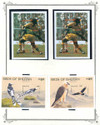
# MCC556 - 1982-90 Bhutan
Issue Dates: 1982-1990
Scott Catalogue Value: $326.75
Mystic Price: $180.00
You Save: $146.75
Mint, never-hinged Bhutan collection has 26 Souvenir Sheets mounted on nine album pages. Highlights include the Birds of Bhutan set, Orchids, and Endangered Wildlife sheets.
Bhutan’s first inhabitants were the Bhutia Tephoo. They were conquered by invaders from Tibet in the early 800s. Bhutan separated from Tibet in the early 1600s when a Tibetan separatist took control. Due to Bhutanese raids on British-controlled India in the 1700s and 1800s, parts of the nation were invaded by Britain. Rule by hereditary monarchy began in 1907, when Ugyen Wangchuk took control and created a powerful centralized government. In 1949, India became more involved in Bhutan’s affairs, eventually placing the country under its protection. China claimed parts of Bhutan in 1959. Closer relations with India have been pursued since then.
The modern population of Bhutan is very ethnic, comprising peoples from the surrounding region. Settlers from Tibet make up approximately two-thirds of the population. All people of Tibetan descent practice Buddhism, which is also the official religion of Bhutan. Buddhist monks or lamas are important members of the community. Among their many responsibilities are the treatment of illness, performance of rituals, and teaching of sacred beliefs. Lamas live in “Dzongs,” or monasteries, which are usually heavily fortified.
People of Indian descent live in small villages near Bhutan’s border with India. These inhabitants practice the Hindu religion. Another important group in Bhutan are descendants of settlers from Burma.
Bhutan’s economy is largely agricultural. Most people have small farms and raise livestock such as cattle, yaks and sheep. Recently, industrialization has been introduced. Products include cement and wood products.
Issue Dates: 1982-1990
Scott Catalogue Value: $326.75
Mystic Price: $180.00
You Save: $146.75
Mint, never-hinged Bhutan collection has 26 Souvenir Sheets mounted on nine album pages. Highlights include the Birds of Bhutan set, Orchids, and Endangered Wildlife sheets.
Bhutan’s first inhabitants were the Bhutia Tephoo. They were conquered by invaders from Tibet in the early 800s. Bhutan separated from Tibet in the early 1600s when a Tibetan separatist took control. Due to Bhutanese raids on British-controlled India in the 1700s and 1800s, parts of the nation were invaded by Britain. Rule by hereditary monarchy began in 1907, when Ugyen Wangchuk took control and created a powerful centralized government. In 1949, India became more involved in Bhutan’s affairs, eventually placing the country under its protection. China claimed parts of Bhutan in 1959. Closer relations with India have been pursued since then.
The modern population of Bhutan is very ethnic, comprising peoples from the surrounding region. Settlers from Tibet make up approximately two-thirds of the population. All people of Tibetan descent practice Buddhism, which is also the official religion of Bhutan. Buddhist monks or lamas are important members of the community. Among their many responsibilities are the treatment of illness, performance of rituals, and teaching of sacred beliefs. Lamas live in “Dzongs,” or monasteries, which are usually heavily fortified.
People of Indian descent live in small villages near Bhutan’s border with India. These inhabitants practice the Hindu religion. Another important group in Bhutan are descendants of settlers from Burma.
Bhutan’s economy is largely agricultural. Most people have small farms and raise livestock such as cattle, yaks and sheep. Recently, industrialization has been introduced. Products include cement and wood products.









